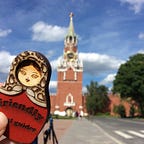33 Fun Facts of the Moscow Kremlin
A record number of tourists visited Moscow in 2014–16.5 million visitors. Guess what is #1 highlight of Moscow? Of course the Kremlin, which has a lot in common with Moscow, by the way.
What is Moscow Kremlin?
Here are the main highlights the Kremlin consists of, combined with a bunch of military and governmental buildings which you can’t see even on a Kremlin tour.
History
1. The Moscow Kremlin is the oldest and the largest fortress in Russia, as well as one of the largest fortresses in Europe.
2. The first settlements in the territory of the Moscow Kremlin relate to the Bronze Age (II millennium BC. E.)
3. Moscow and the Kremlin have one father. The fortress was built on the orders of the founder of Moscow — Prince Yuri Dolgoruky.
4. The Moscow Kremlin was first a wooden, then stone and finally a brick structure, used to be a city in itself, surrounded by ramparts, towers and battlements in ancient times.
Timeline
5. Since 1264 was the residence of the feudal princes of Moscow.
6. The Moscow Kremlin got its power and fame thanks to Ivan Kalita in 14th century, who made the Kremlin the main part of the city, and Moscow — the strongest city in the ancient Rus.
7. The double-horned notched teeth on the top of the Kremlin walls are similar to “swallowtail”, and in Italy they are used on the locks of the Italian Guelphs and Ghibellines. Kremlin walls are crowned with a total of 1045 “swallowtails”.
8. The Moscow Kremlin was often compared to the Scaligero castle in Verona and Castello Sforzesco in Milan, thanks to the Italian architects who constructed the Kremlin cathedrals in 15th
9. Famous Kremlin chimes in existence since the 16th century. They were manufactured in 1625 under the leadership of the British engineer Christopher Halloway.
10. The Kremlin was the residence of Russian princes and tsar from 13th to 18th century, and then for Communist leaders starting with Lenin in 1918. Nowadays it’s the official residence of the President of Russia.
Kremlin Clock
11. Various sources claim that the Kremlin clock on the Spasskaya Tower appeared between 1491 and 1585
12. In 1625 British clockmaker Christopher Galloway with the help of Russian engineers completed the new clock.
13. In 1706 Peter the Great transported a new clock from Holland in 30 wagons, from Amsterdam to Moscow.
14. Finally, in 1851 the modern Kremlin Clock was remodeled by the Butenop brothers, Moscow merchants, originally from Holland.
15. The rim, numbers and hands were covered with gold (28 kg of gold in all).
16. The total weight of clock and bells is 25 tons.
Kremlin as a Fortress
17. Almost every town of the Golden Ring of Russia has its own Kremlin.
18. The Moscow Kremlin has an irregular shape, is in the form of a triangle and is surrounded by massive walls and towers.
19. With the beginning of the Northern War in 1721 Peter I ordered to erect bastions along the Kremlin wall.
20. Apart from the Kremlin towers, there were towers protecting the bridge to the Kremlin. The only one survived is Kutafya tower, built in 1516.
21. The Kremlin wall was surrounded and protected with additional fortifications of Kitay Gorod, White City, Earthen city.
Kremlin nowadays
22. The best observation points on the Kremlin are from the Big Moskvoretsky, Stone, and Patriarch Bridges, as well as Ivan the Great Bell tower, and O2 lounge bar in National hotel.
23. The Moscow Kremlin is a UNESCO World Natural and Cultural Heritage.
24. The Kremlin is nowadays estimated at 1.5 trillion Russian rubles (based on calculations of a consulting group “Uphill”).
Kremlin stars
25. In 1937 the Kremlin replaced Tsar double-headed eagles with ruby stars as the symbol of Kremlin. The stars are believed to have a powerful energy.
26. The weight of each of the Kremlin stars is more than a ton.
27. The stars are whirling and easily rotate, turning their “face” to the wind.
Tsar Cannon and Tsar Bell
28. Two paradoxes of Russia: the biggest bell that never rang and the biggest cannon that never shot.
29. A Tsar Cannon is a symbol of Russian power, a 40-ton weapon that fired just once — with ashes of the enemy in 17th Cast in 1586. Tsar Cannon was included in the Guinness Book as the largest cannon by caliber.
30. Tsar Bell is really the biggest bell in the world, created in the years of 1733–1735. Tsar Bell mainly consists of copper, but also contains gold (72 kg) and silver (525 kg).
Kremlin Ghosts
31. The ghost of Ivan the Terrible was believed to live for several centuries in the Bell tower.
32. The torture chamber of Constantine and Helen Tower produced the sounds of blood drops.
33. Even the ghost of Vladimir Ilyich Lenin was supposedly seen in his former office in the Kremlin.
Original source: https://friendlylocalguides.com/blog/33-fun-facts-from-our-kremlin-tours
